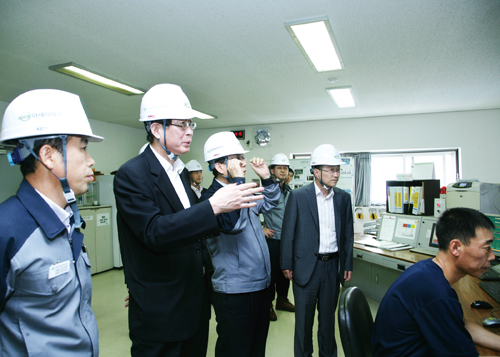Power major spearheads nationwide power conservation activities to tide over the current power shortage crisis

KEPCO President Cho Hwan-eik visits Asia Paper Mfg. Co. on June 4 on a leg of his inspection tours of
electricity-engulping firms to solicit their participation in demand management systems.
Korea Electric Power Corp. (KEPCO) is devoting all its energies to spearhead a nationwide campaign to conserve electricity in a desperate effort to prevent blackouts.
KEPCO is translating into action a code of public conduct on saving energy by turning off half of all the lights and keeping indoor temperatures above 28 degrees Centigrade during power peak hours, while its site businesses have “designated watchmen” in charge of ensuring energy conservation so as to cut down on unessential consumption.
KEPCO staff members are asked to have lunch at 11 a.m. one hour before noon, contributing to redistributing energy demand load. In particular, the KEPCO headquarters has an electricity consumption management system in place to conserve electricity on an hour basis. KEPCO has replaced its 25,000 office lights with energy-efficient LED lights. KEPCO officials are on hand in a nationwide drive to solicit the general public’s participation in energy conservation activities by holding street campaigns around districts clustered with high energy consumers.
KEPCO has come up with creative ideas for conserving electricity, including a power conservation points system for residential consumers and a critical peak pricing (CPP) system for industrial clients, with its staff members taking the initiative in translating into action energy-saving campaigns.
Under the power conservation points system, residential clients, including apartments, are allowed to accumulate power conservation points when they have a monthly electricity consumption reduction of more than 20 percent during August and September compared to their average electricity consumption during each month of the period between 2010 and 2012, and they will receive a deduction in their electricity charges any time they want during the remaining months of this year. Clients who reduce their consumption by more than 30 percent compared to the previous years will have their electricity fees reduced by 10 percent, while those who conserve less than 30 percent but more than 20 percent will be given a 5 percent discount on their electricity bills. _전기전약BG.jpg)
Under the CPP system, industrial clients will be charged 3.4 times more than the average power consumption unit price during peak load hours-between 11 a.m. and noon and between 1 p.m. and 5 p.m. But they will be charged 0.8 times lower than the average power consumption price unit during the non-peak load hours. The system will be expanded to include industrial customers who have a contract to consume less than 5,000kW per month. Last winter, those who had a contract to consume less than 3,000kW benefited from the system.
KEPCO staff members are asked to keep indoor temperatures at 28 degrees Centigrade or higher in a campaign for creating the “Eco-Office.” They are advised to wear “cooler and simpler clothes.”
Officials at power grid operation centers, dispatch centers, and transformation stations are participating in drills against emergency rolling blackouts. They are undergoing mock exercises based on varying warning stages being issued through SMS services.
KEPCO President Cho Hwan-eik himself has been making the rounds of manufacturing plants to solicit their participation in demand management systems.
KEPCO plans to stage nationwide power conservation campaigns through 3 million SNS accounts of public entities under the Ministry of Trade, Industry and Energy and other public entities.
Cho said diverse power conservation campaigns will be staged during the period between June and September. “We’re going to hold nationwide energy conservation drives to overcome the power shortage crisis during the summer in a smart fashion.”
